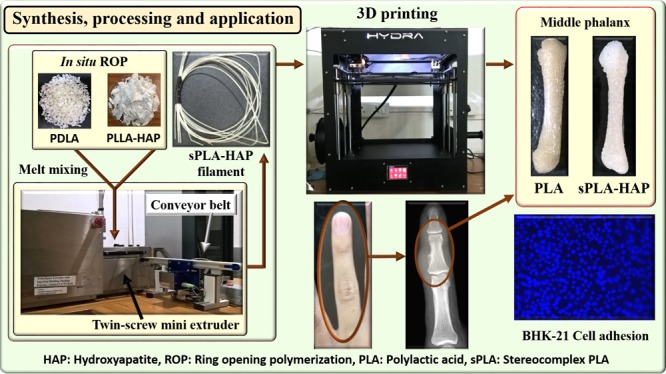- Record: found
- Abstract: found
- Article: not found
Multifunctional Nanohydroxyapatite-Promoted Toughened High-Molecular-Weight Stereocomplex Poly(lactic acid)-Based Bionanocomposite for Both 3D-Printed Orthopedic Implants and High-Temperature Engineering Applications

Read this article at
Abstract

The current work focuses on the fabrication of high-molecular-weight stereocomplex poly(lactic acid)/nanohydroxyapatite (sPLA/n-HAP)-based bionanocomposite for three-dimensional (3D)-printed orthopedic implants and high-temperature engineering applications. To achieve the same, n-HAP is grafted with poly( d-lactic acid) (PDLA) via in situ ring-opening polymerization of d-lactide, followed by blending with poly( l-lactic acid) (PLLA), which yields sPLA/n-HAP biocomposite with improved storage modulus even at temperatures higher than 140 °C. X-ray diffraction and calorimetric analysis ensure the presence of 100% stereocomplex crystallites of biocomposite along with significant improvement in the melting temperature (∼227 °C). Noteworthy improvements in the mechanical and gas-barrier properties of the developed biocomposites are achieved due to the uniform dispersion of n-HAP (∼60 nm) confirmed by morphological studies. An unusual improvement in elongation at break (∼130% at 1 wt % HAP loading) makes this composite a toughened material. However, the tensile strength is improved by ∼16%, whereas oxygen permeability and water vapor transmission rate are found to reduce by ∼48 and ∼34%, respectively. Interestingly, the developed material is processed as monofilament, followed to 3D printing to yield a middle phalanx bone as a representative example of orthopedic implants. In vitro studies reveal that cell adhesion and proliferation on the surface of the developed biocomposite support its biocompatible nature. This signifies the possible future aspects of the material in commercial biomedical and high-temperature engineering applications.
Related collections
Most cited references58
- Record: found
- Abstract: not found
- Article: not found
Stereocomplex formation between enantiomeric poly(lactides)
- Record: found
- Abstract: not found
- Article: not found
Literature Review of Poly(Lactic Acid) A Literature Review of Poly(Lactic Acid)
- Record: found
- Abstract: not found
- Article: not found
